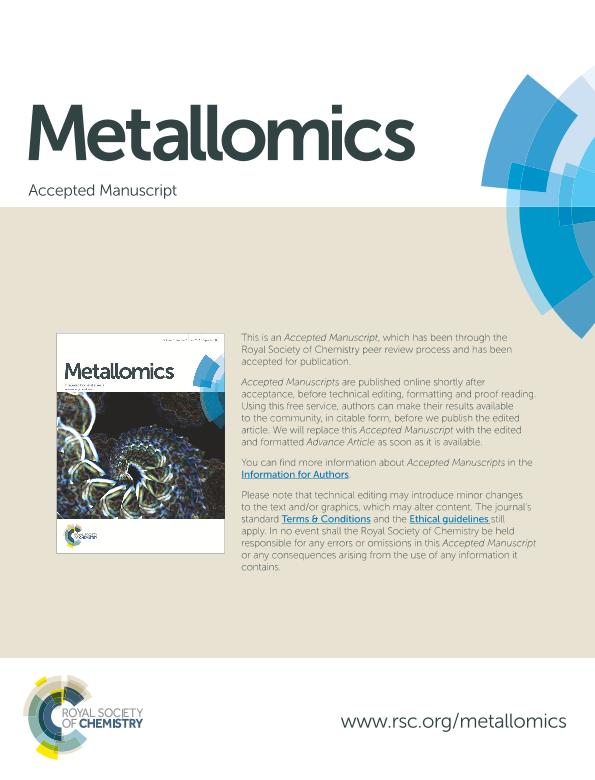Artículo
Brain antioxidant responses to acute iron and copper intoxications in rats
Semprine, Jimena Vanina ; Ferrarotti, Nidia; Musacco Sebio, Rosario Natalia
; Ferrarotti, Nidia; Musacco Sebio, Rosario Natalia ; Saporito Magriñá, Christian Martín
; Saporito Magriñá, Christian Martín ; Fuda, Julián; Torti, Horacio; Castro Parodi, Mauricio; Damiano, Alicia Ermelinda
; Fuda, Julián; Torti, Horacio; Castro Parodi, Mauricio; Damiano, Alicia Ermelinda ; Boveris, Alberto Antonio
; Boveris, Alberto Antonio ; Repetto, Marisa G.
; Repetto, Marisa G.
 ; Ferrarotti, Nidia; Musacco Sebio, Rosario Natalia
; Ferrarotti, Nidia; Musacco Sebio, Rosario Natalia ; Saporito Magriñá, Christian Martín
; Saporito Magriñá, Christian Martín ; Fuda, Julián; Torti, Horacio; Castro Parodi, Mauricio; Damiano, Alicia Ermelinda
; Fuda, Julián; Torti, Horacio; Castro Parodi, Mauricio; Damiano, Alicia Ermelinda ; Boveris, Alberto Antonio
; Boveris, Alberto Antonio ; Repetto, Marisa G.
; Repetto, Marisa G.
Fecha de publicación:
08/2014
Editorial:
Royal Society Of Chemistry
Revista:
Metallomics
ISSN:
1756-5901
Idioma:
Inglés
Tipo de recurso:
Artículo publicado
Clasificación temática:
Resumen
Dose- and time-dependent antioxidant responses to Fe (0–60 mg kg−1) and Cu overloads (0–30 mg kg−1) in rat brains are described by the C50 and the t1/2, the brain metal concentration and the time for half maximal oxidative responses. Brain GSH and the GSH/GSSG ratio markedly decreased after Fe and Cu treatments (50–80%) with a t1/2 of 9–10 h for GSH and of 4 h for GSH/GSSG for both metals. The GSH/GSSG ratio was the most sensitive indicator of brain oxidative stress. The decrease of GSH and the increase of in vivo chemiluminescence had similar time courses. The C50 for brain chemiluminescence, GSH and hydrophilic and lipophilic antioxidants were in similar ranges (32–36 μg Fe g−1 brain and 10–18 μg Cu g−1 brain), which indicated a unique free-radical mediated process for each metal. The brain concentration of hydrophilic and lipophilic antioxidants decreased after Fe and Cu loads; hydrophilic antioxidants decreased by 46–68% with a t1/2 of 10–11 h and lipophilic antioxidants decreased by 75–45% with a t1/2 of 10–12 h. Cu,Zn-SOD and CAT activities and the protein expression were adaptively increased (100–90% after Fe and Cu loads), with a t1/2 of 8–12 h. GPx-4 activity decreased after both metal loads by 73–27% with a t1/2 of 8–4 h with decreased protein expression.
Palabras clave:
Iron
,
Cupper
,
Sod
,
Catalase
,
Gpx
Archivos asociados
Licencia
Identificadores
Colecciones
Articulos(IFIBIO HOUSSAY)
Articulos de INSTITUTO DE FISIOLOGIA Y BIOFISICA BERNARDO HOUSSAY
Articulos de INSTITUTO DE FISIOLOGIA Y BIOFISICA BERNARDO HOUSSAY
Citación
Semprine, Jimena Vanina; Ferrarotti, Nidia; Musacco Sebio, Rosario Natalia; Saporito Magriñá, Christian Martín; Fuda, Julián; et al.; Brain antioxidant responses to acute iron and copper intoxications in rats; Royal Society Of Chemistry; Metallomics; 6; 11; 8-2014; 2083-2089
Compartir
Altmétricas



